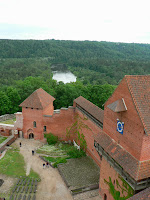 |
| Turaida Church |
While we were standing by Gutmanis cave, Aija told us the story of the Rose
of Turaida. Around 1620, two lovers,
Victor and Maija (the Rose) had met in the cave and Maija had died there when
a Polish deserter tried to rape her.
 |
| Daisy Covered Lawn |
So the next stop was the Turaida Museum Reserve.
Once inside, we walked to the small church, lying on the main path of the reserve. While the others were in the church, I marvelled at
the lawns to the side and around the back.
They were almost white, being covered in masses of daisies.
 |
| Statue of Kronvalda Atis |
We walked on up to Dainas Hill.
Dainas means folk song and the hill is an important symbol of the Singing
Revolution (1987-1991), one of the landmark events in the move towards
independence, when songs were used to protest against soviet rule. Singing was also very important for Aija and
she often sang folk songs to us when we were in the bus.
Dainas Hill is covered in granite sculptures. The first statue was of Krišjānis
Barons, being supported by a strong
man, although it looked as if the strong man was his ear. Krišjānis Barons is known as the
Father of Folk Songs. Aija said he
collected 218,000 folk songs and spent his last years in the Gauja valley. Every morning he climbed up the hill, so the
Folk Song Hill was made there. Aija said that the other sculptures
represented folksongs. As we walked past
some of the statues, she sang the appropriate folksong.
 |
| Donjon Tower, Turaida Castle |
At the far end of the hill was a stand of eleven trees. Apparently, there had been twelve, but one
died as did its replacement. This would
have been a sacred spot in pagan days, so I went and stood in the middle.
 |
| Turaida Castle from Donjon Tower |
Then it was our turn to sing.
Aija told us to sing a song from our country. Us English sang “Yesterday” and the
Australians did “Waltzing Matilda”. Flo
tried singing the Canadian national anthem.
Despite the huge number of songs written in the USA, Susie sang a song
no one else knew – and neither, as it soon turned out, did Susie, so she gave
up. We sang “Danny Boy” for Charlie and
he looked quite moved. I would have
liked to have done a “Crowded House” one for him. Bob and Ann sang a Welsh song and we all
helped May with a rendition of “Auld Lang Syne”. Then Aija got us to join in with the chorus
of a Latvian folksong. It was all fun,
but we stood still for so long that I got bitten through my leggings by some vicious insects.
 |
| Turaida Castle & River Gauja from Donjon Tower |
Then we walked on to Turaida Castle, where Aija pointed out all the
buildings and left us alone to explore.
I wanted to walk on the walls, so I climbed the stairs of the building next
to the walkway – only to find that it was a dead end. So I went down and tried the “donjon”
tower. Two flights of stairs took me to
a jewellery shop, which was a bit incongruous.
Another four flights, including three long winding flights, took me to
the top.
 |
| Turaida Castle from Donjon Tower |
The view over the meandering River Gauja was magnificent. I could also look down on the other castle
buildings and all the other sights on the reserve.
 |
| Turaida Castle across River Gauja |
I allowed myself a brief recovery from the climb and looked out of all
the windows in every direction. I could
see May and Janet down below and tried, in vain, to attract their attention.
Then I prepared myself for the descent.
There were no handrails on the winding flights, but I could keep contact
with the walls and go down sideways, one stair at a time. Three flights down, I passed Janet on her way
up. I had a rest in the jewellery shop
and then reached the bottom without mishap.













































